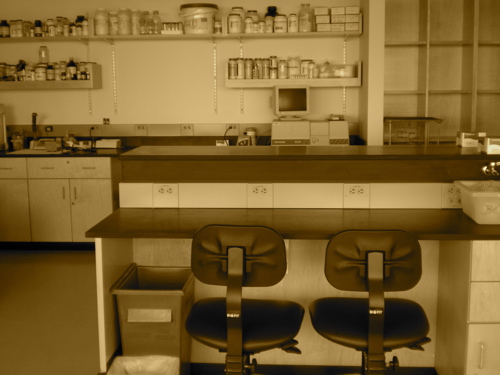Difference between revisions of "20.109(S10):RNA to DNA by RT-PCR (Day5)"
(→Part 2: RT-PCR) |
(→Introduction) |
||
| Line 2: | Line 2: | ||
==Introduction== | ==Introduction== | ||
| + | |||
| + | The amount of RNA recovered after a column purification is quite small. Thus, in the next step of SELEX, you must increase this small amount of RNA in a stable way. First (today) you convert it to DNA and amplify it, using RT-PCR. Then (next time), you perform a second in vitro transcription reaction to make more of the actual RNA aptamer. For this process to work, the 6-5 and 8-12 aptamers must amplify at the same rate. This fact has been proven for these particular aptamers under the conditions that we are using. | ||
==Protocols== | ==Protocols== | ||
Revision as of 19:02, 6 January 2010
Contents
Introduction
The amount of RNA recovered after a column purification is quite small. Thus, in the next step of SELEX, you must increase this small amount of RNA in a stable way. First (today) you convert it to DNA and amplify it, using RT-PCR. Then (next time), you perform a second in vitro transcription reaction to make more of the actual RNA aptamer. For this process to work, the 6-5 and 8-12 aptamers must amplify at the same rate. This fact has been proven for these particular aptamers under the conditions that we are using.
Protocols
Part 1: Recover RNA
- Centrifuge your samples at max speed for 15 minutes.
- You and partner can balance your tubes against each other.
- Collect the supernatants into a temporary waste bottle, such as a 15 mL conical tube.
- Add one mL of 70-80% ethanol to each sample, and vortex vigorously.
- Spin for two minutes at max speed.
- Repeat the wash step with 1 mL of fresh 70-80% ethanol.
- Dry your samples in the fume hood for 10 minutes, then resuspend each one in 44 μL of RNase-free water.
Part 2: RT-PCR
HAVE THEM DO THE CONTROL I DID, OF MAKING SURE 6-5 AND 8-12 AMPLIFY AT SAME RATE?
- The thermal cycler will be preheated to 50 °C while you prepare your samples. This is required for the procedure to work optimally.
- Set up your reactions on a cold block as usual. From one of the shared stocks, pipet 30 μL of Master Mix into each well-labeled PCR tubes.
- In the interests of economy, we will not run control reactions this time. However, if you wanted to test for contamination of your reaction, what component would you leave out?
- Add 20 μL of your recovered RNA to the Master Mix.
- The following thermal cycler program will be used:
| Segment | Cycles | Temperature (° C) | Time | Purpose |
|---|---|---|---|---|
| 1 | 1 | 50 | 30 min | reverse transcription |
| 2 | 1 | 95 | 15 min | activate polymerase, deactivate RT enzymes, denature template |
| 3-5 | 20 | 94 | 30 sec | denature (PCR) |
| 57 | 1 min | anneal (PCR) | ||
| 72 | 1 min | extend (PCR) | ||
| 4 | 1 | 72 | 7 min | final extension |
After the RT-PCR is completed, the teaching faculty will store the samples in the freezer until next time.
PROBABLY WILL RUN OUT ON GEL (JUST DONE BY TEACHING FACULTY?) BUT NOT TAKE TIME TO PURIFY
